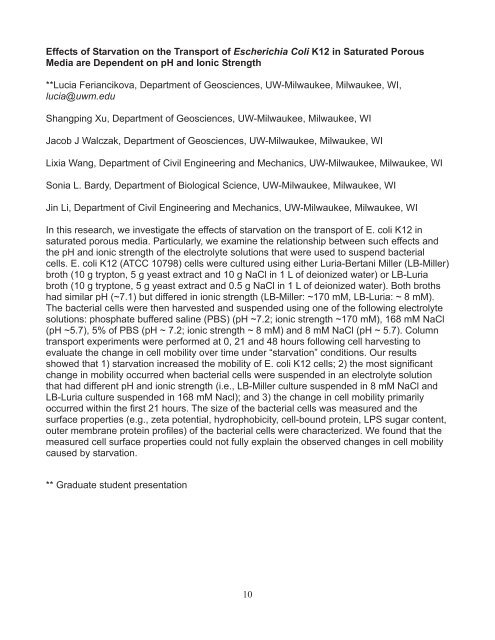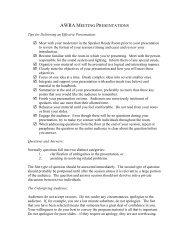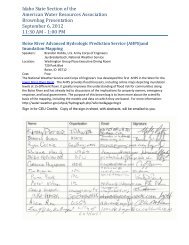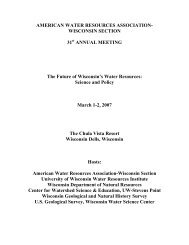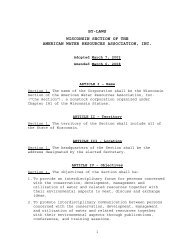Wisconsin's Role in Great Lakes Restoration - American Water ...
Wisconsin's Role in Great Lakes Restoration - American Water ...
Wisconsin's Role in Great Lakes Restoration - American Water ...
Create successful ePaper yourself
Turn your PDF publications into a flip-book with our unique Google optimized e-Paper software.
Effects of Starvation on the Transport of Escherichia Coli K12 <strong>in</strong> Saturated Porous<br />
Media are Dependent on pH and Ionic Strength<br />
**Lucia Feriancikova, Department of Geosciences, UW-Milwaukee, Milwaukee, WI,<br />
lucia@uwm.edu<br />
Shangp<strong>in</strong>g Xu, Department of Geosciences, UW-Milwaukee, Milwaukee, WI<br />
Jacob J Walczak, Department of Geosciences, UW-Milwaukee, Milwaukee, WI<br />
Lixia Wang, Department of Civil Eng<strong>in</strong>eer<strong>in</strong>g and Mechanics, UW-Milwaukee, Milwaukee, WI<br />
Sonia L. Bardy, Department of Biological Science, UW-Milwaukee, Milwaukee, WI<br />
J<strong>in</strong> Li, Department of Civil Eng<strong>in</strong>eer<strong>in</strong>g and Mechanics, UW-Milwaukee, Milwaukee, WI<br />
In this research, we <strong>in</strong>vestigate the effects of starvation on the transport of E. coli K12 <strong>in</strong><br />
saturated porous media. Particularly, we exam<strong>in</strong>e the relationship between such effects and<br />
the pH and ionic strength of the electrolyte solutions that were used to suspend bacterial<br />
cells. E. coli K12 (ATCC 10798) cells were cultured us<strong>in</strong>g either Luria-Bertani Miller (LB-Miller)<br />
broth (10 g trypton, 5 g yeast extract and 10 g NaCl <strong>in</strong> 1 L of deionized water) or LB-Luria<br />
broth (10 g tryptone, 5 g yeast extract and 0.5 g NaCl <strong>in</strong> 1 L of deionized water). Both broths<br />
had similar pH (~7.1) but differed <strong>in</strong> ionic strength (LB-Miller: ~170 mM, LB-Luria: ~ 8 mM).<br />
The bacterial cells were then harvested and suspended us<strong>in</strong>g one of the follow<strong>in</strong>g electrolyte<br />
solutions: phosphate buffered sal<strong>in</strong>e (PBS) (pH ~7.2; ionic strength ~170 mM), 168 mM NaCl<br />
(pH ~5.7), 5% of PBS (pH ~ 7.2; ionic strength ~ 8 mM) and 8 mM NaCl (pH ~ 5.7). Column<br />
transport experiments were performed at 0, 21 and 48 hours follow<strong>in</strong>g cell harvest<strong>in</strong>g to<br />
evaluate the change <strong>in</strong> cell mobility over time under “starvation” conditions. Our results<br />
showed that 1) starvation <strong>in</strong>creased the mobility of E. coli K12 cells; 2) the most significant<br />
change <strong>in</strong> mobility occurred when bacterial cells were suspended <strong>in</strong> an electrolyte solution<br />
that had different pH and ionic strength (i.e., LB-Miller culture suspended <strong>in</strong> 8 mM NaCl and<br />
LB-Luria culture suspended <strong>in</strong> 168 mM Nacl); and 3) the change <strong>in</strong> cell mobility primarily<br />
occurred with<strong>in</strong> the first 21 hours. The size of the bacterial cells was measured and the<br />
surface properties (e.g., zeta potential, hydrophobicity, cell-bound prote<strong>in</strong>, LPS sugar content,<br />
outer membrane prote<strong>in</strong> profiles) of the bacterial cells were characterized. We found that the<br />
measured cell surface properties could not fully expla<strong>in</strong> the observed changes <strong>in</strong> cell mobility<br />
caused by starvation.<br />
** Graduate student presentation<br />
10


